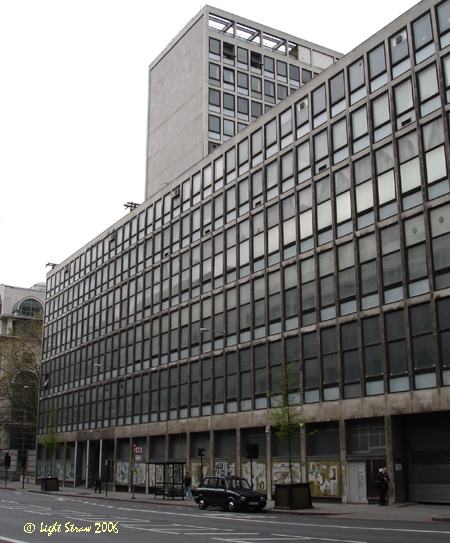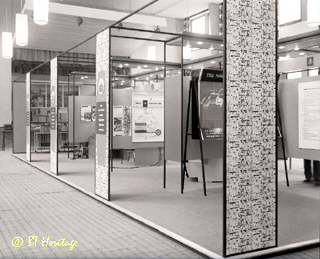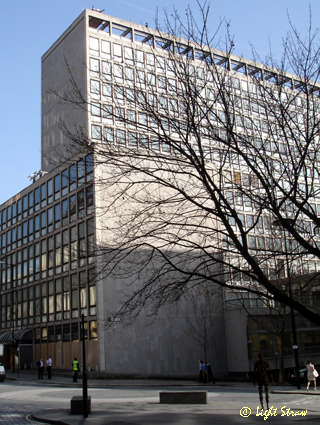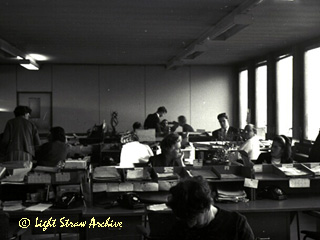Farringdon Street and Shoe Lane
 |
Fleet Building, Farringdon Street, London EC2, was named after the course of the old Fleet River (long since covered over) and nearby Fleet Street. |
Fleet Building was another vast telecommunications centre, which was designed by W.S. Frost under guidance from chief architect Eric Bedford, of the Ministry of Works. This 14 storey building was completed in 1960 and up to 2014 occupied a large site between Shoe Lane and Farringdon Street.
Fleet Building replaced the Central Telegraph Office (CTO) which finally closed in 1962.
The New Central Telegraph Office
Extract from leaflet PG239 10/62: Visits to Post Office Telecommunications Buildings in London.
"The new Central Telegraph Office is in Fleet Building in Farringdon Street. The building was erected in 1959 and is the largest to be built for the Post Office since the war. It also houses two Telephone Managers' Offices and the Inland and International Telex exchanges.
The planning and installation of the new Central Telegraph Office has taken over three years and a very great deal of care and thought have gone into it. Full advantage has been taken of a number of improvements in both equipment and message handling technique that have been developed in recent years, and the new office is probably one of the most up-to-date of its type in the world. The primary aims have been to obtain maximum efficiency and to produce an agreeable working environment for the staff. Indeed, the staff themselves, through their representatives, have played a valuable part in the planning of the new office.
One major innovation is the introduction of a queueing system for phonogram calls. By this means telephone calls to 'Telegrams' are automatically presented to the operators in the order in which they are made. Any call that does not find an operator immediately available goes into a call queue, the size of this queue being automatically related to the number of staff available to answer the calls. This will avoid danger of any 'unfortunate' calls being overlooked and ensure that a better and more uniform service is given to callers.
A great deal of attention has been given to the problem of work-flow, with the object of minimising the transfer of messages between the various parts of the office and thus reducing the time between the receipt of messages and their subsequent transmission. So far as practicable, related functions have been grouped together, or in some cases combined. For example, the traditional method of handling a phonogram is for an operator in the phonogram section to accept it from the customer and to send it either by hand or mechanical conveyance to another operator who teleprints it to its destination. Under some conditions these two functions will both be performed by the same operator in the new Central Telegraph Office.
The furniture on which the new equipment is mounted is also of a new pattern, purpose-made and designed with a pleasant and modern contour and finish. Electrically driven conveyor bands are installed on most of the tables including some of a special new design which will automatically distribute messages to working positions. Another feature of the equipment is the mounting of some of the receiving teleprinters in vertical stacks of three instead of arranging them horizontally on tables. This enables an operator to handle three machines whilst sitting down instead of having to walk from one to the other.
The main telegraph room itself is light and airy with a modern decor and a sound-proof ceiling. So far as practicable, the equipment also has been sound-proofed. A large dining room, lounge, games room, locker and First Aid rooms are available in the building which also contains a large hall for official and social gatherings. Most of the staff required for the administrative work of the Central Telegraph Office are housed on the 12th floor from which they have magnificent views over the City. A new telegraph school will be installed on the first floor and this too, will be provided with the most modern equipment. It will also be arranged that it can act as a relief telegraph office should there be any serious mishap to the Central Telegraph Office itself.
The new Central Telegraph Office will handle about 25,000 telegrams on an average day, but it has spare capacity to carry the quite considerable overloads that occur from time to time. The total staff will exceed 600. It will still be the delivery office (DO) for the EC3 and EC4 areas during the day and for the whole of London at night.
So after nearly 90 years the Central Telegraph Office has moved to a new home; one very different in its physical aspects, but in which, without doubt, the staff will continue the spirit of efficient and willing service that has always characterised this office."
Leaflet designed and produced by London Typographical Designers Limited and printed in England by Raithby Lawrence & Co.Ltd. PG 239 10/62
The Design
Fleet Telex
Installation of the Fleet Telex Exchange began in May 1959 at which stage only 4 floors had been constructed; such was the urgent need of a home for the new equipment as the Telex Service was converted to automatic working. Fleet exchange handled all calls for:
London Charging Group
Home Counties (as hypothetical exchanges) including:
- Brighton
- Canterbury
- Colchester
- Guildford
- Luton
- Norwich
- Oxford
- Portsmouth
- Reading
- Southend-on-Sea
- Tunbridge Wells
Fleet was both a Telex Zone Exchange and an International Switching Centre.
1963 - The new cordless international telex switchboard was opened in Fleet Building.
Fleet had a capacity for 12,000 subscriber lines and until 1970 was the only international telex exchange.
ISD
The first International Subscriber Dialling (ISD) call was made by the Lord Mayor of London (Sir Ralph Perring) at 11am on 8th March 1963. Calling from Fleet Building, he dialled 13 digits and was connected to Monsieur Jacques Marette, the French Minister of Posts, Telegraphs and Telephones, in Paris.
TMOs
Fleet Building housed two Telephone Managers' Offices which included Waterloo's Traffic Office...
Waterloo Traffic Office
Varley Non-Director I/C
As part of the telephone STD network, Varley ND I/C exchange opened in Fleet Building in 1968. Varley used ferrite core Register Translators.
Telephone Museum
Fleet Building once housed a 'museum of telecommunications equipment and techniques' and some of the exhibits would have been transferred to the BT Museum, and in later years to the Connected-Earth partners.
 |
Fleet's spacious accommodation was ideally suited to large exhibition displays. |
All logos and trade marks are the property of their respective owners and are used on the Light Straw site(s) for review only. Students and researchers are recommended to make their own independent enquiries as to the accuracy of the information contained therein.

